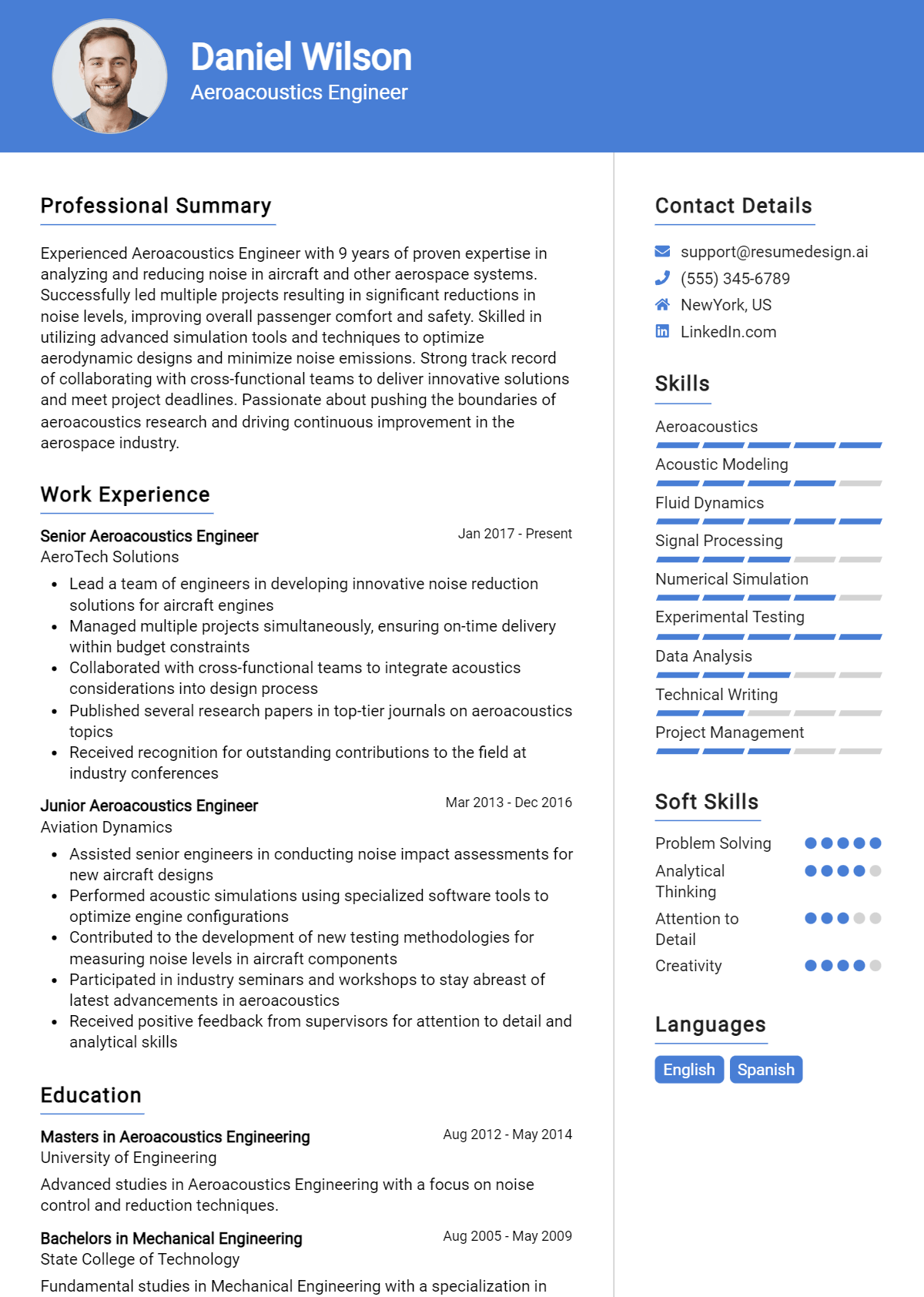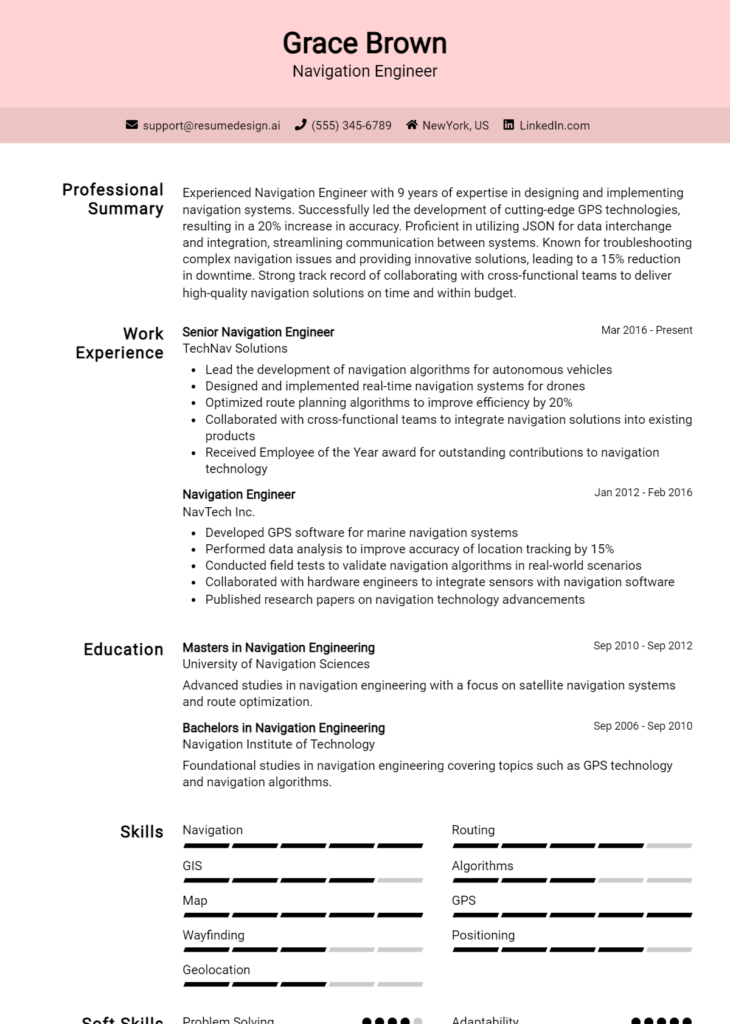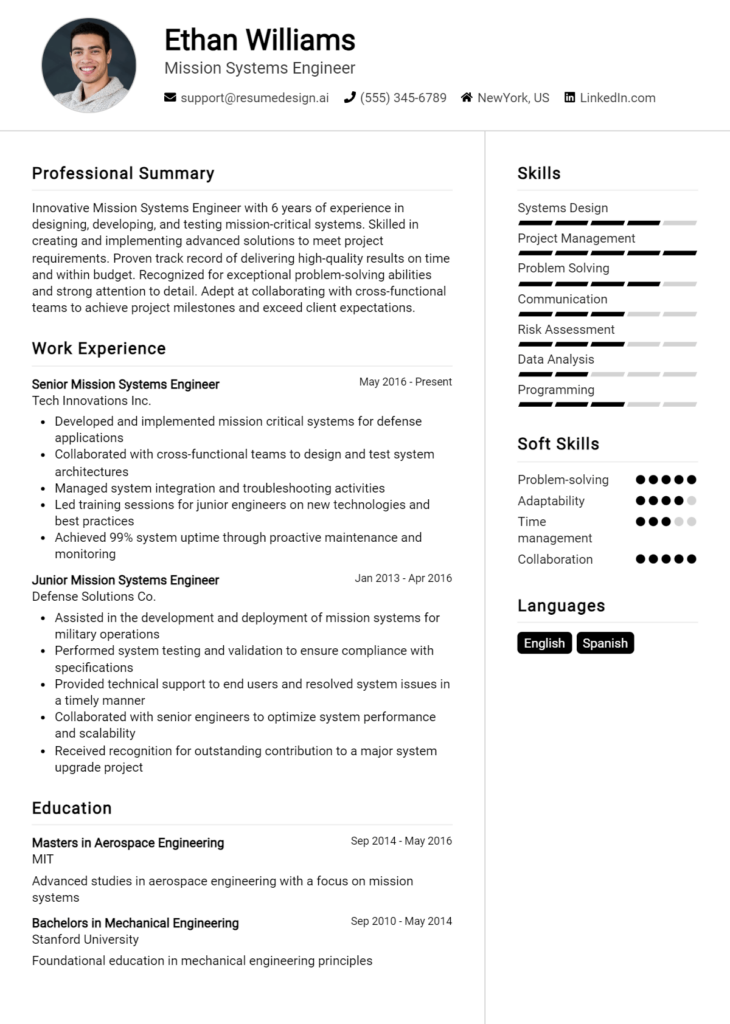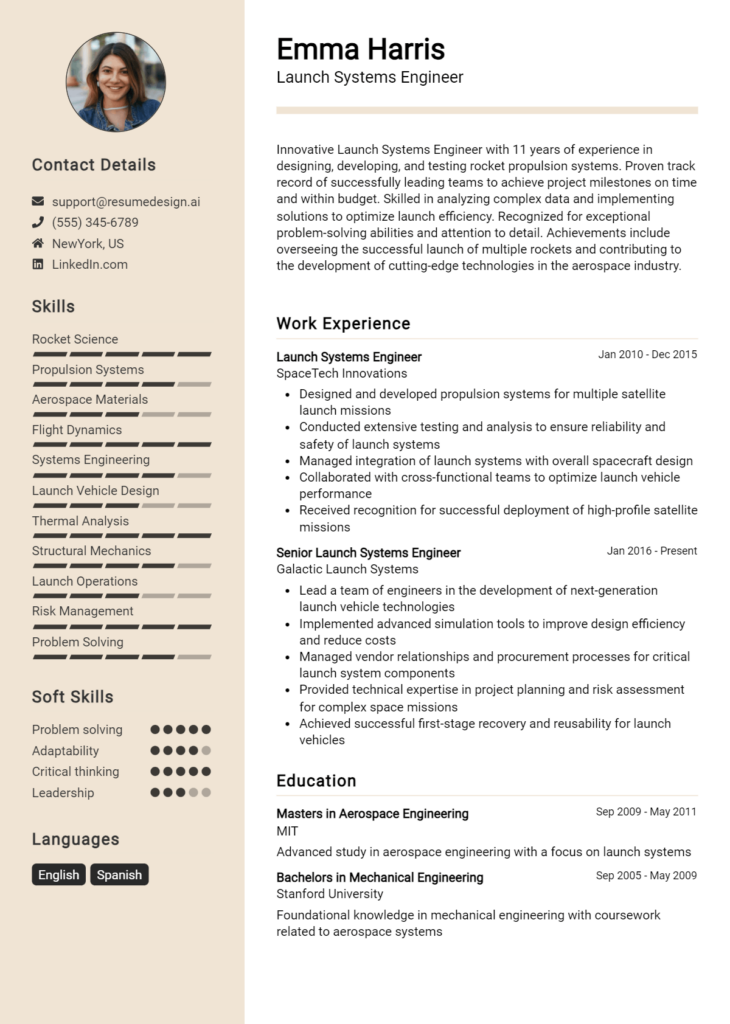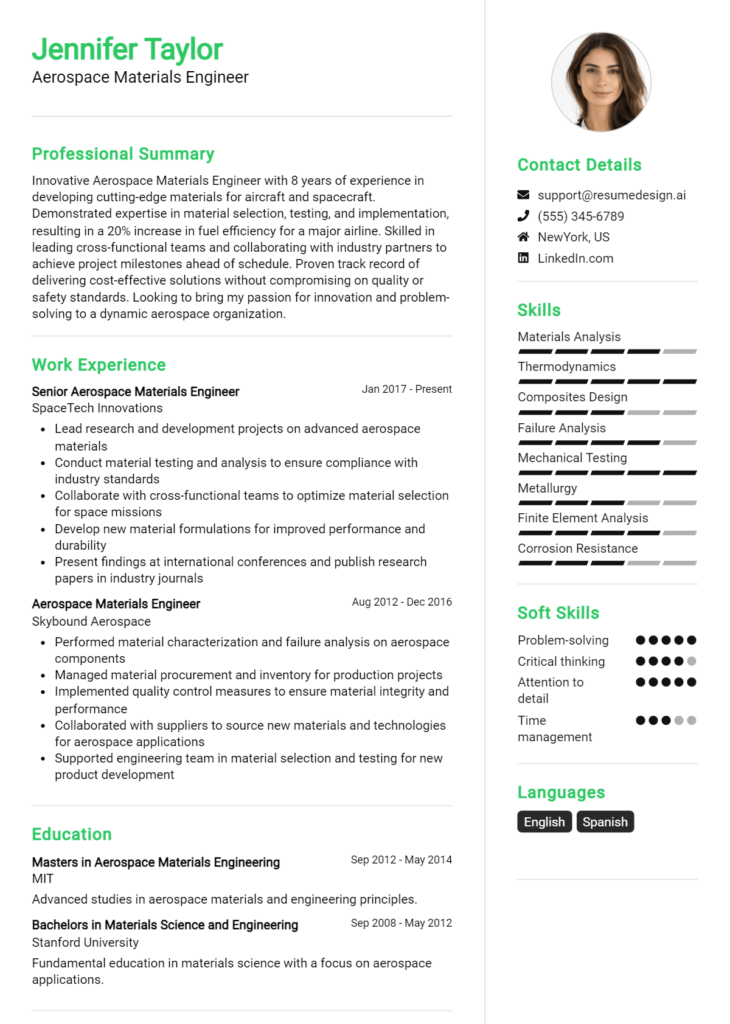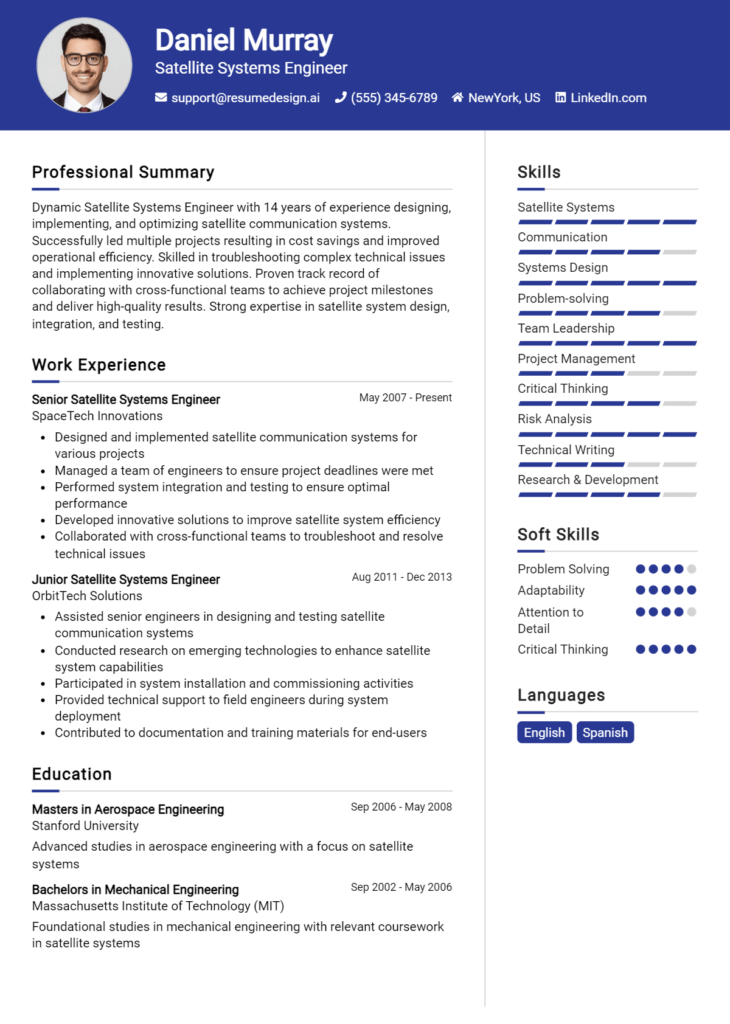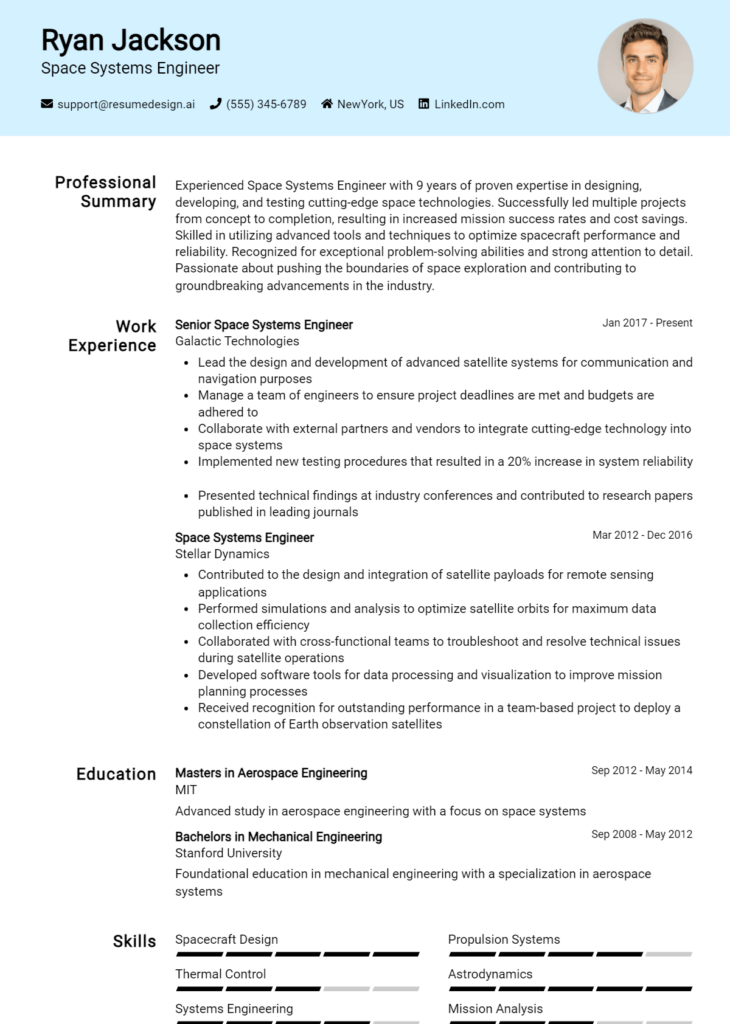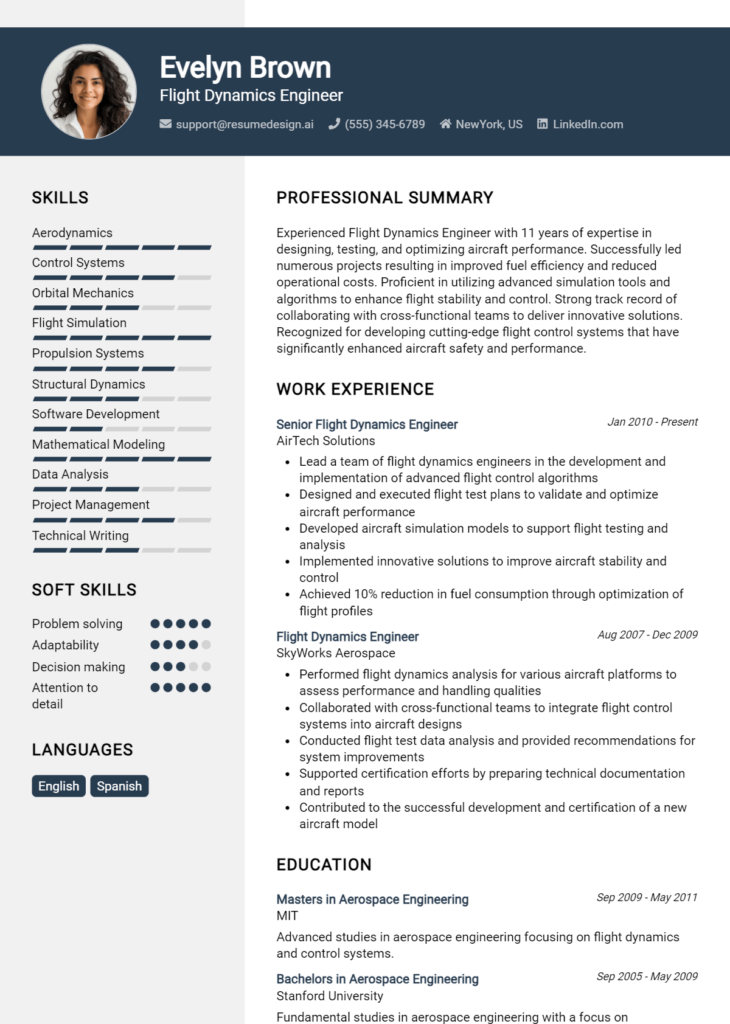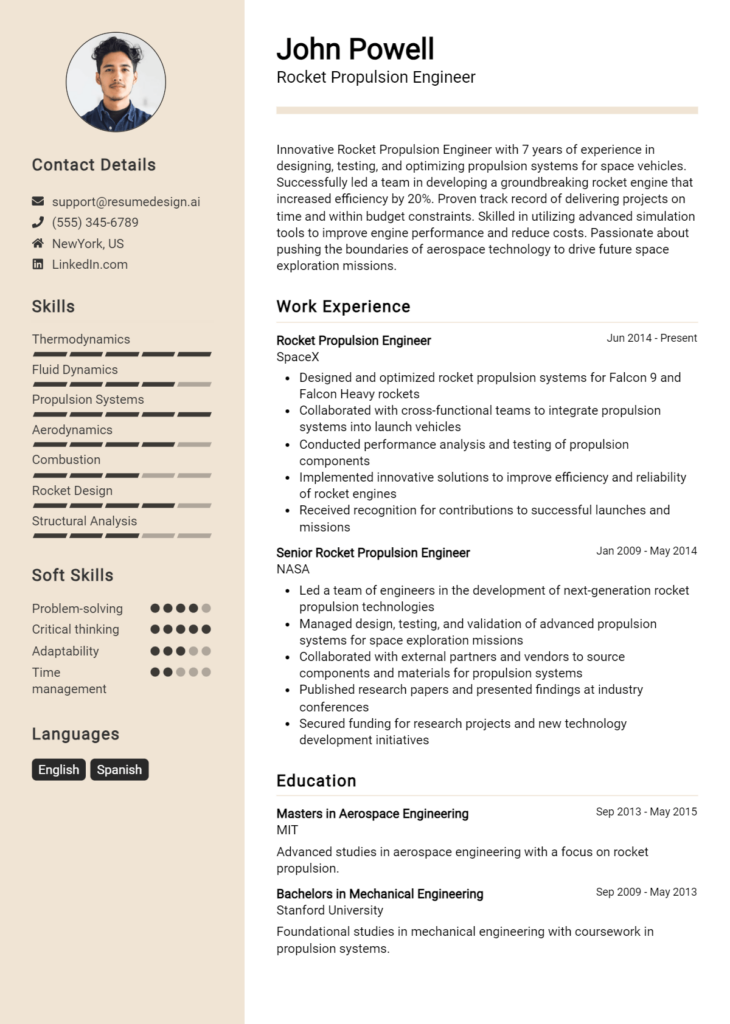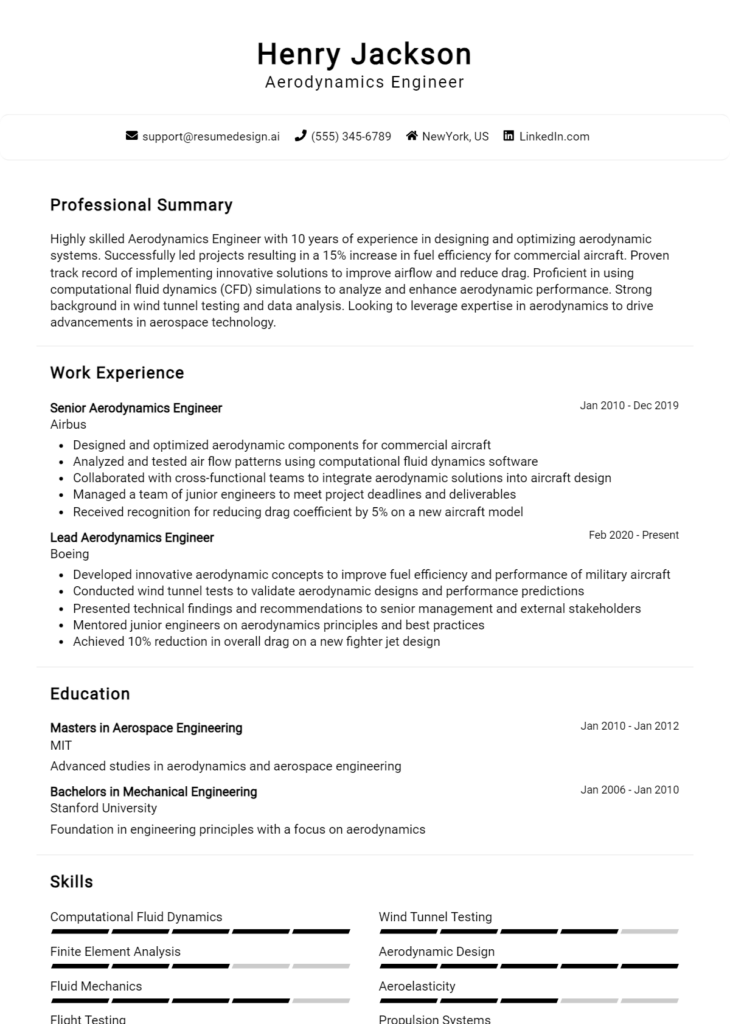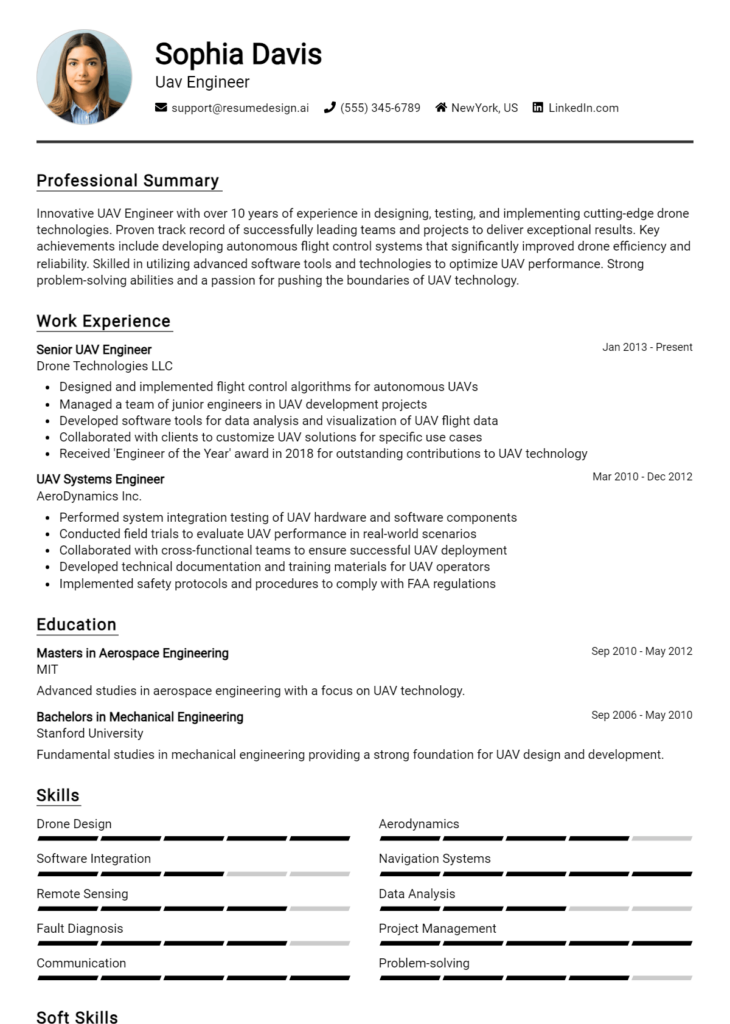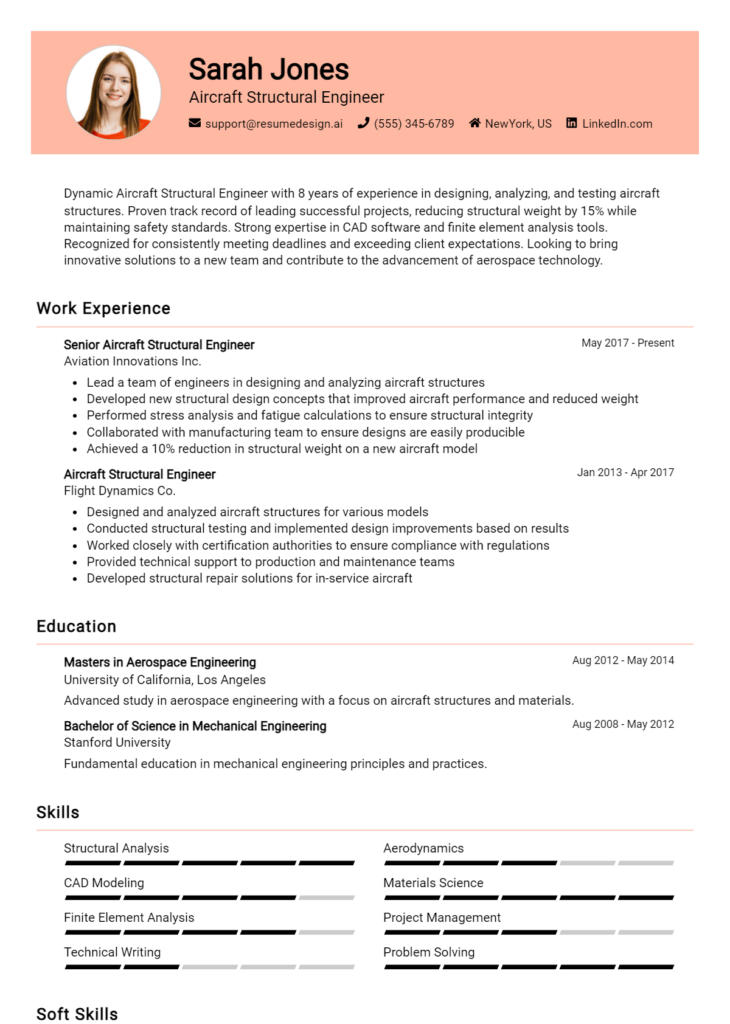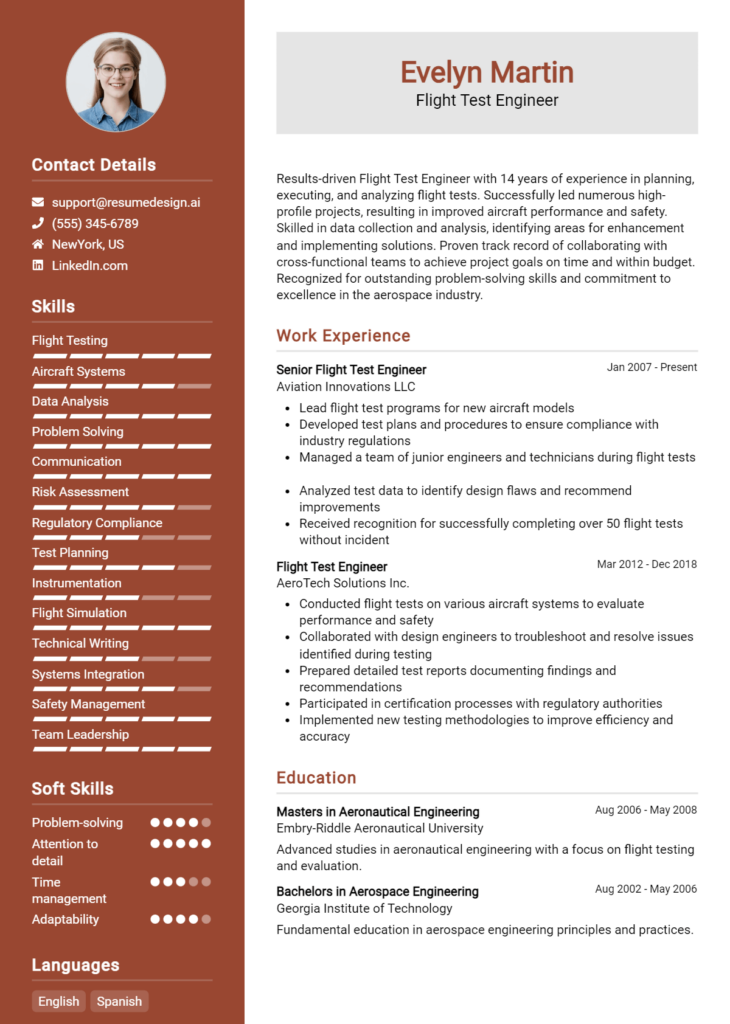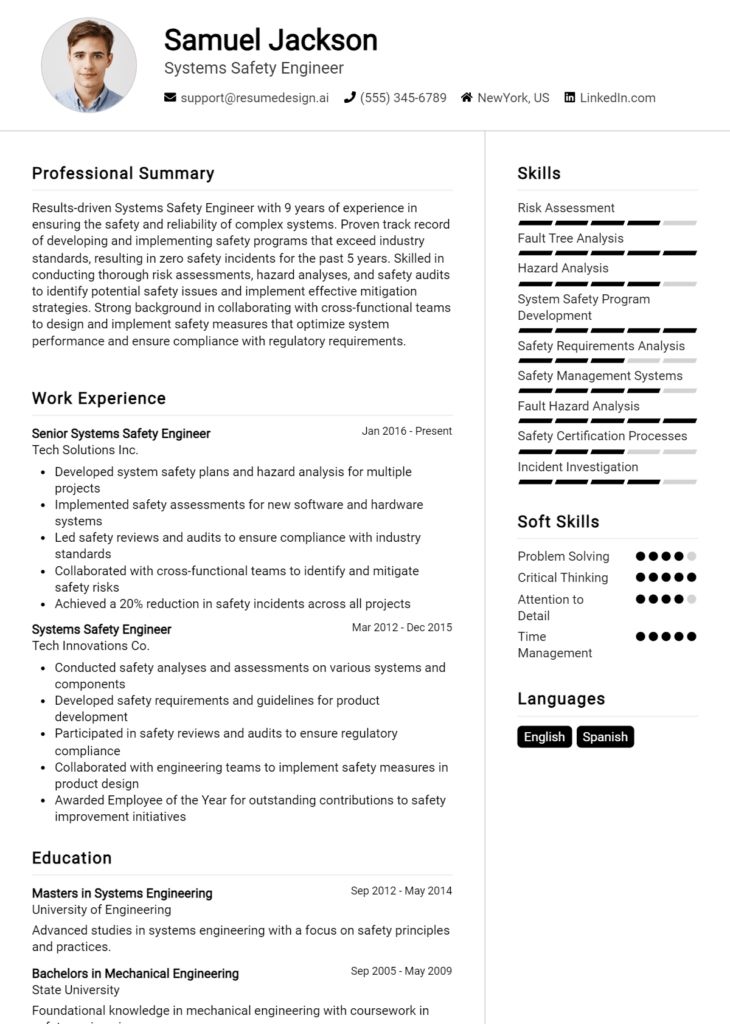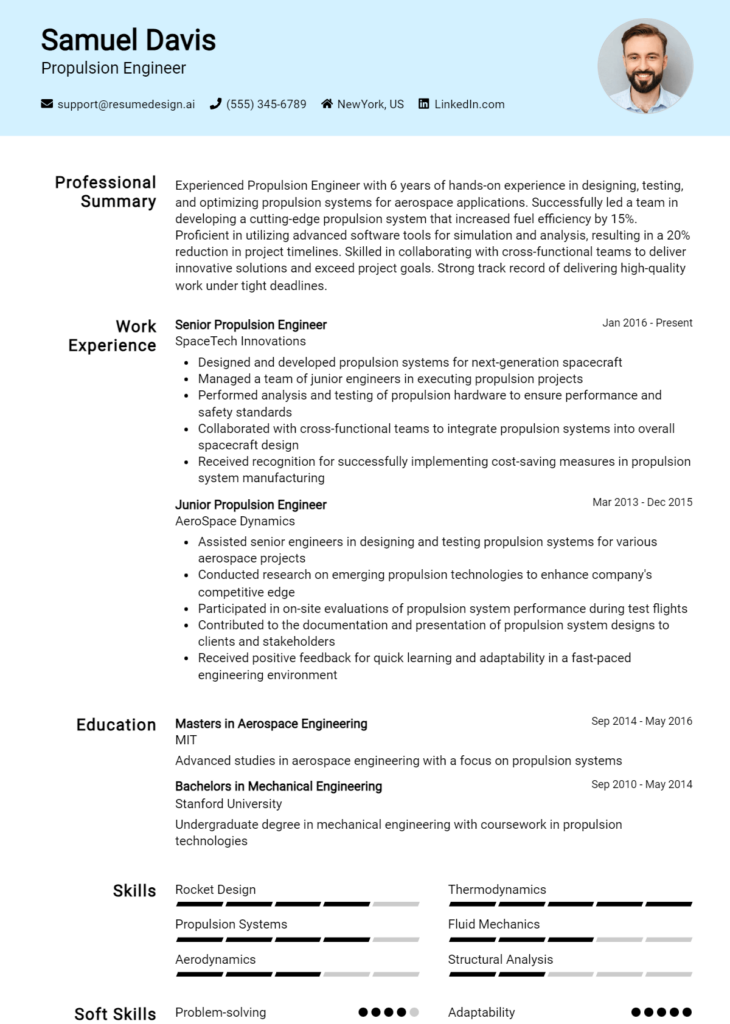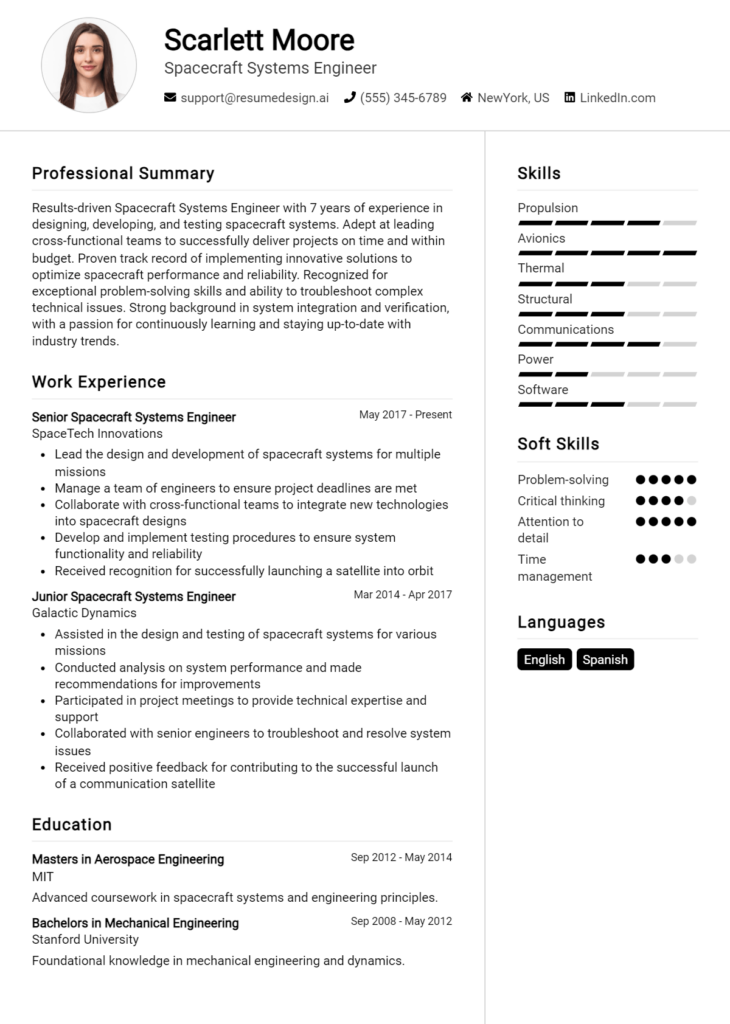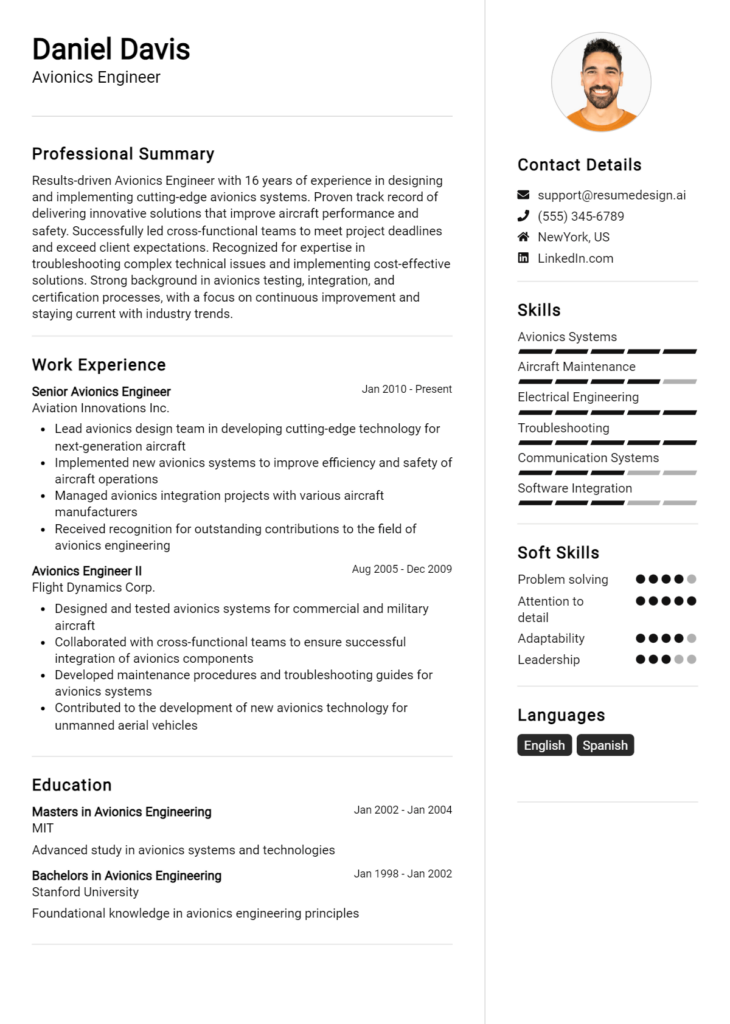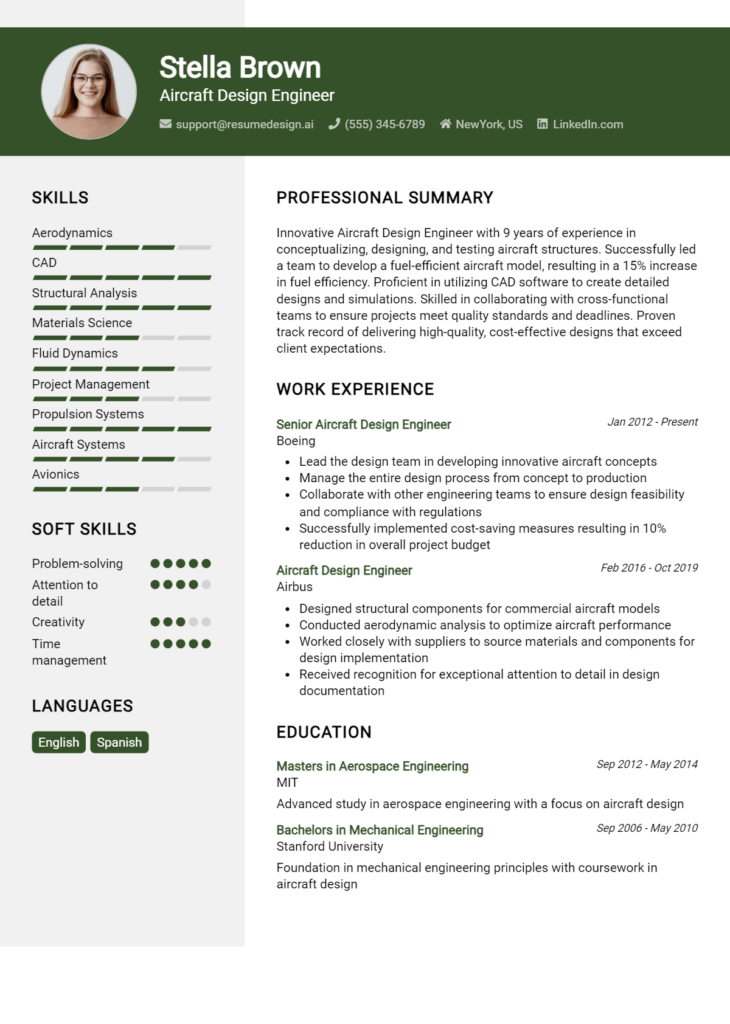Aeroacoustics Engineer Core Responsibilities
An Aeroacoustics Engineer is responsible for analyzing and mitigating noise generated by aircraft and aerospace systems, requiring strong technical, operational, and problem-solving skills. This role bridges various departments, including design, manufacturing, and testing, ensuring that acoustic performance aligns with regulatory standards and organizational goals. Successful engineers must possess proficiency in acoustics modeling software, data analysis, and communication skills to collaborate across teams. A well-structured resume can effectively highlight these qualifications, showcasing the candidate's contributions to noise reduction and overall project success.
Common Responsibilities Listed on Aeroacoustics Engineer Resume
- Conduct acoustic modeling and simulations to predict noise levels.
- Perform experimental testing and data analysis on noise emissions.
- Collaborate with design teams to optimize aircraft structures for noise reduction.
- Develop and implement noise control strategies and technologies.
- Ensure compliance with relevant noise regulations and standards.
- Prepare technical reports and presentations for stakeholders.
- Utilize computational fluid dynamics (CFD) tools for noise analysis.
- Engage in cross-functional teams to address acoustic challenges.
- Stay updated on advancements in aeroacoustic research and technology.
- Contribute to the development of noise mitigation policies and practices.
- Assist in the training of junior engineers and interns.
High-Level Resume Tips for Aeroacoustics Engineer Professionals
In the competitive field of aerodynamics and acoustics, a well-crafted resume is essential for Aeroacoustics Engineer professionals seeking to make a strong impression on potential employers. Your resume is often the first point of contact with hiring managers, serving as a critical reflection of your skills, experience, and achievements. A compelling resume not only showcases your technical expertise but also communicates your ability to contribute effectively to a team and solve complex problems. This guide will provide practical and actionable resume tips specifically tailored for Aeroacoustics Engineer professionals, helping you to stand out in a crowded job market.
Top Resume Tips for Aeroacoustics Engineer Professionals
- Tailor your resume to the specific job description by incorporating keywords and phrases that match the requirements outlined in the posting.
- Highlight relevant experience in aerodynamics, acoustics, and engineering, focusing on projects that demonstrate your problem-solving abilities.
- Quantify your achievements by using metrics and data to illustrate the impact of your work, such as reductions in noise levels or improvements in design efficiency.
- Emphasize your proficiency in industry-specific software and tools, such as Computational Fluid Dynamics (CFD) software and acoustic modeling programs.
- Showcase your educational background, including relevant degrees and certifications, to underscore your expertise in the field.
- Include professional affiliations and memberships in relevant organizations to demonstrate your commitment to continuous learning and networking.
- Utilize a clean and professional format that makes your resume easy to read and highlights the most important information at a glance.
- Incorporate a summary statement at the top of your resume that succinctly captures your professional identity and career objectives.
- Be concise and eliminate any unnecessary information that does not directly pertain to the Aeroacoustics Engineer role.
- Proofread for grammar and spelling errors, as attention to detail is crucial in engineering roles.
By implementing these tailored resume tips, Aeroacoustics Engineer professionals can significantly enhance their chances of landing a job in this specialized field. A focused and well-structured resume not only showcases your qualifications but also demonstrates your understanding of the industry, making you a more appealing candidate to potential employers.
Why Resume Headlines & Titles are Important for Aeroacoustics Engineer
In the competitive field of aeroacoustics engineering, a well-crafted resume headline or title is crucial for capturing the immediate interest of hiring managers. A strong headline serves as a powerful introduction, summarizing a candidate's key qualifications, skills, and experience in a concise and impactful manner. It acts as a hook that draws attention and encourages hiring managers to delve deeper into the resume. By ensuring that the headline is relevant and directly related to the specific job being applied for, candidates can effectively showcase their strengths and stand out in a crowded job market.
Best Practices for Crafting Resume Headlines for Aeroacoustics Engineer
- Keep it concise: Aim for one impactful phrase that captures your essence.
- Make it role-specific: Tailor the headline to the specific position you are applying for.
- Highlight key skills: Incorporate important skills relevant to aeroacoustics engineering.
- Use industry terminology: Employ language that resonates within the aeroacoustics field.
- Showcase achievements: Include quantifiable accomplishments if applicable.
- Avoid clichés: Steer clear of generic phrases that do not differentiate you.
- Maintain professionalism: Ensure a formal tone that reflects your engineering background.
- Consider your audience: Tailor your headline to appeal to the specific hiring manager or organization.
Example Resume Headlines for Aeroacoustics Engineer
Strong Resume Headlines
Innovative Aeroacoustics Engineer with 7+ Years of Experience in Noise Reduction Solutions
Results-Driven Engineer Specializing in Computational Fluid Dynamics for Aeroacoustic Applications
Accomplished Aeroacoustics Specialist with Proven Track Record in Aircraft Noise Compliance
Weak Resume Headlines
Engineer Looking for Opportunities
Aeroacoustics Professional
The strong headlines are effective because they provide specific information about the candidate's experience, skills, and achievements in aeroacoustics, making a memorable first impression. They clearly communicate the candidate's value proposition and demonstrate relevance to the job at hand. In contrast, the weak headlines fail to impress because they are vague, lacking any detail that would highlight the candidate's unique qualifications or strength. This lack of specificity makes it difficult for hiring managers to see the potential fit for the role, diminishing the candidate's chances of standing out.
Writing an Exceptional Aeroacoustics Engineer Resume Summary
A well-crafted resume summary is crucial for an Aeroacoustics Engineer as it serves as the first impression for hiring managers. This brief introductory paragraph can effectively capture attention by highlighting key skills, relevant experience, and notable accomplishments that align with the job role. A strong summary is concise, impactful, and tailored specifically to the position being applied for, allowing candidates to stand out in a competitive job market.
Best Practices for Writing a Aeroacoustics Engineer Resume Summary
- Quantify achievements: Use specific numbers and metrics to demonstrate your impact in previous roles.
- Highlight relevant skills: Focus on technical skills and competencies that are directly applicable to the job.
- Tailor your summary: Customize your summary for each job application to align with the job description and company values.
- Be concise: Aim for 3-5 sentences that deliver your core message without unnecessary fluff.
- Use strong action verbs: Start sentences with powerful verbs to convey your proactive approach.
- Incorporate keywords: Use relevant industry terms and keywords from the job listing to pass applicant tracking systems (ATS).
- Showcase unique experiences: Highlight any specialized training or experience that sets you apart from other candidates.
- Maintain a professional tone: Keep the language formal and focused on your professional capabilities.
Example Aeroacoustics Engineer Resume Summaries
Strong Resume Summaries
Results-driven Aeroacoustics Engineer with over 5 years of experience in noise reduction and advanced acoustic modeling. Successfully led a project that reduced aircraft noise levels by 30%, exceeding regulatory standards and enhancing passenger comfort.
Dedicated Aeroacoustics Engineer proficient in computational fluid dynamics and acoustic simulation. Developed innovative solutions that decreased sound emissions by 25% in commercial aircraft, contributing to a 15% increase in customer satisfaction ratings.
Detail-oriented Aeroacoustics Engineer with a proven track record in developing state-of-the-art noise control technologies. Collaborated on a team that achieved a 40% reduction in engine noise, significantly improving product compliance and market competitiveness.
Weak Resume Summaries
Aeroacoustics Engineer with some experience looking for a new opportunity. Interested in working on exciting projects and contributing to the team.
Engineer with a background in noise control and acoustics seeking a position in a reputable company. Eager to learn and grow in the field.
The examples provided highlight the difference between strong and weak resume summaries. Strong summaries effectively convey specific achievements and relevant skills, showcasing quantifiable results that demonstrate the candidate's impact and suitability for the role. In contrast, weak summaries remain vague, lack measurable outcomes, and fail to present a clear picture of the candidate's capabilities, making them less compelling to hiring managers.
Work Experience Section for Aeroacoustics Engineer Resume
The work experience section of an Aeroacoustics Engineer resume plays a critical role in demonstrating a candidate's technical expertise and their capacity to lead teams and projects effectively. This section serves as a platform for showcasing specific skills related to aeroacoustics, such as noise prediction, sound quality assessment, and computational fluid dynamics. It is essential for candidates to highlight their achievements quantitatively, indicating how they contributed to the success of previous projects or organizations. Aligning work experience with industry standards and expectations is crucial to illustrate their readiness for the challenges of the role and to ensure they stand out among potential candidates.
Best Practices for Aeroacoustics Engineer Work Experience
- Use action verbs to describe your responsibilities and accomplishments.
- Quantify achievements with specific metrics, such as noise reduction percentages or project budgets.
- Highlight collaboration with cross-functional teams, including design, manufacturing, and testing departments.
- Detail technical skills applied in past roles, such as software tools or modeling techniques used in aeroacoustics analysis.
- Showcase leadership experiences, including mentoring junior engineers or leading project teams.
- Align your experience with industry standards, emphasizing any compliance with regulations or standards.
- Tailor your work experiences to the job description, focusing on relevant skills and accomplishments.
- Include professional development activities, such as certifications or training related to aeroacoustics.
Example Work Experiences for Aeroacoustics Engineer
Strong Experiences
- Led a team of 5 engineers in a project that successfully reduced aircraft cabin noise by 12 dB, resulting in a 15% increase in customer satisfaction ratings.
- Developed and implemented an innovative noise prediction model that decreased computational time by 30%, enabling faster design iterations.
- Collaborated with the design team to optimize exhaust system components, resulting in a 20% reduction in aerodynamic drag and a 10% increase in fuel efficiency.
- Presented findings at the International Conference on Aeroacoustics, receiving recognition for advancing industry understanding of noise control techniques.
Weak Experiences
- Worked on noise reduction projects.
- Assisted with various engineering tasks.
- Participated in team meetings and discussions.
- Helped with some modeling and analysis work.
The examples of strong experiences are considered effective because they provide clear, quantifiable results of the candidate's contributions, demonstrate leadership and collaboration, and highlight specific technical skills relevant to the aeroacoustics field. In contrast, the weak experiences lack detail and measurable outcomes, making them less impactful and failing to convey the candidate's true capabilities or achievements in the industry.
Education and Certifications Section for Aeroacoustics Engineer Resume
The education and certifications section of an Aeroacoustics Engineer resume plays a crucial role in showcasing the candidate's academic achievements, industry-relevant credentials, and commitment to continuous professional development. This section not only highlights the foundational knowledge gained through formal education but also emphasizes any specialized training and certifications that enhance the candidate's credibility. By including relevant coursework and industry-recognized certifications, candidates can effectively demonstrate their alignment with the job role and their preparedness to tackle the technical challenges associated with aeroacoustics engineering.
Best Practices for Aeroacoustics Engineer Education and Certifications
- Focus on relevant degrees in aerospace engineering, mechanical engineering, or acoustics.
- Include industry-recognized certifications such as Certified Noise Control Engineer (CNCE) or similar credentials.
- Detail specialized training or workshops related to aeroacoustics or noise control technologies.
- List relevant coursework that pertains directly to acoustics, fluid dynamics, and sound propagation.
- Highlight any advanced degrees (Master’s or PhD) that demonstrate higher expertise in the field.
- Include any ongoing education efforts, such as online courses or professional development seminars.
- Ensure all entries are up-to-date and accurately reflect your qualifications.
- Use clear formatting to make it easy for hiring managers to quickly assess your educational background and certifications.
Example Education and Certifications for Aeroacoustics Engineer
Strong Examples
- M.S. in Aerospace Engineering, University of Michigan, 2021
- Certified Noise Control Engineer (CNCE), 2022
- Relevant coursework: Advanced Acoustics, Fluid Dynamics, and Noise Control Engineering
- Ph.D. in Mechanical Engineering with a focus on Aeroacoustics, Stanford University, 2023
Weak Examples
- Bachelor's Degree in General Studies, State University, 2018
- Certification in Basic Computer Skills, 2020
- Online course in Graphic Design, 2019
- High School Diploma, 2016
The examples provided are considered strong because they are directly relevant to the field of aeroacoustics engineering, showcasing advanced degrees and certifications that align with industry standards. They demonstrate a clear commitment to specialized knowledge and skills needed for the role. Conversely, the weak examples lack relevance to the aeroacoustics discipline, featuring qualifications that do not contribute to the candidate's capabilities in the field, thereby diminishing their overall credibility and suitability for an Aeroacoustics Engineer position.
Top Skills & Keywords for Aeroacoustics Engineer Resume
In the competitive field of aeroacoustics engineering, showcasing the right skills on your resume can significantly enhance your chances of landing your desired position. Employers in this specialized sector seek candidates who not only possess technical expertise but also demonstrate essential soft skills that contribute to effective teamwork and project management. Highlighting a balanced mix of hard and soft skills can make your resume stand out, indicating your capability to tackle complex challenges in aerodynamics and noise control. A well-crafted resume that emphasizes your skills is crucial for demonstrating your qualifications and aligning with the expectations of potential employers in this niche area of engineering.
Top Hard & Soft Skills for Aeroacoustics Engineer
Soft Skills
- Strong communication skills
- Team collaboration
- Problem-solving abilities
- Critical thinking
- Attention to detail
- Adaptability
- Project management
- Creativity and innovation
- Time management
- Leadership qualities
Hard Skills
- Acoustics modeling and simulation
- Computational Fluid Dynamics (CFD)
- Finite Element Analysis (FEA)
- Noise control techniques
- Experimental acoustics
- MATLAB and other programming languages
- Data analysis and interpretation
- Knowledge of aeroacoustic design principles
- Proficiency in CAD software
- Understanding of regulatory standards and compliance
For a deeper exploration into how to effectively present your skills and work experience, consider researching best practices that will elevate your resume to meet industry standards.
Stand Out with a Winning Aeroacoustics Engineer Cover Letter
Dear [Hiring Manager's Name],
I am writing to express my enthusiasm for the Aeroacoustics Engineer position at [Company Name], as advertised on [where you found the job listing]. With a Master's degree in Aerospace Engineering and over five years of specialized experience in aeroacoustic analysis and noise reduction techniques, I am excited about the opportunity to contribute to your team's innovative projects aimed at advancing aerospace technology.
In my previous role at [Previous Company Name], I successfully led a project that focused on reducing aircraft noise during takeoff and landing phases. By utilizing advanced computational fluid dynamics (CFD) simulations and experimental techniques, my team was able to achieve a 15% reduction in noise levels, which significantly improved compliance with environmental regulations. My strong analytical skills and proficiency in tools such as ANSYS and COMSOL Multiphysics have equipped me to tackle complex acoustic challenges effectively, ensuring that design solutions are both efficient and compliant with industry standards.
Moreover, my collaborative approach and ability to communicate complex technical concepts to multidisciplinary teams have proven invaluable in fostering a productive work environment. I am particularly drawn to [Company Name] because of its commitment to sustainability and innovation in aerospace engineering. I am eager to bring my expertise in aeroacoustics to your projects and contribute to developing quieter, more efficient aircraft that meet the growing demands for environmental stewardship in the aviation industry.
Thank you for considering my application. I look forward to the opportunity to discuss how my background, skills, and enthusiasms align with the goals of [Company Name]. I am eager to help your team achieve its objectives and drive advancements in aeroacoustic technologies.
Sincerely,
[Your Name]
[Your Contact Information]
[Your LinkedIn Profile or Website, if applicable]
Common Mistakes to Avoid in a Aeroacoustics Engineer Resume
When crafting a resume for an Aeroacoustics Engineer position, it's crucial to present your skills and experiences effectively. However, many candidates make common mistakes that can undermine their chances of landing an interview. Avoiding these pitfalls will enhance your resume's impact and showcase your qualifications more clearly to potential employers.
Lack of Specificity: Failing to include specific details about projects or technologies used can make your experience seem vague. Clearly describe your contributions and the outcomes of your work in aeroacoustics.
Ignoring Keywords: Many employers use applicant tracking systems (ATS) to filter resumes. Not incorporating relevant industry keywords can lead to your resume being overlooked. Analyze the job description for important terms and include them in your resume.
Overly Technical Language: While technical expertise is vital, using excessive jargon can alienate hiring managers who may not have a deep technical background. Aim for a balance between technical details and accessible language.
Inconsistent Formatting: A disorganized or inconsistent format can distract from the content of your resume. Ensure uniformity in font sizes, bullet points, and spacing to create a clean, professional appearance.
Neglecting Soft Skills: Aeroacoustics engineers often work in teams and must communicate effectively. Omitting soft skills such as teamwork, communication, and problem-solving can make your application less compelling.
Missing Quantifiable Achievements: Employers appreciate measurable results. Failing to include quantifiable achievements, like percentage improvements in noise reduction or project completion timelines, can weaken your impact.
Too Much Focus on Responsibilities: Merely listing job responsibilities rather than focusing on accomplishments can make your resume less engaging. Highlight specific achievements and how they contributed to the success of your projects.
Not Tailoring the Resume: Sending out a generic resume for different positions can diminish your chances. Customize your resume for each application to align your skills and experiences with the specific requirements of each job.
Conclusion
As an Aeroacoustics Engineer, you play a crucial role in addressing noise control and sound quality in aerospace applications. Your expertise in fluid dynamics, acoustics, and engineering principles helps design quieter aircraft and improve passenger comfort. The importance of your skills cannot be overstated—employers seek professionals who can analyze noise sources, develop innovative solutions, and collaborate effectively with multidisciplinary teams.
In this competitive field, having a standout resume is essential to showcase your technical skills, relevant experience, and contributions to projects. Ensure that your resume highlights your proficiency in computational methods, experimental techniques, and your ability to apply acoustic theory in real-world scenarios. Don't forget to include any specialized software skills and certifications that can set you apart from other candidates.
To enhance your job application, consider reviewing your Aeroacoustics Engineer resume today. Take advantage of the variety of resources available to you, including resume templates, a convenient resume builder, comprehensive resume examples, and tailored cover letter templates. With the right tools at your disposal, you can create a compelling resume that effectively highlights your qualifications and helps you stand out in the job market.

